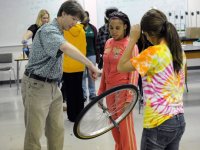The Biggest Hurdle to Flipping Your Class
I have been asked on a number of occasions what is the biggest hurdle that teachers need to overcome in order to flip their classrooms. In my experience, the number one hurdle is that teachers need to flip their thinking about class time.
Stepping Back from an Old Model
When teachers flip their classes, I believe they must ask one key question: What is the best use of class time? Is it information dissemination, or is it something else? I argue that we need to get away from direct instruction to the whole group and instead use class time for richer and more meaningful activities and interactions.
Why is this a big hurdle? I think it is because many of us have been doing school the same way for many years. I spent 19 years as a lecture/discussion teacher. I knew how to teach that way. In fact, I reached the point where if you told me the topic of the day, I could flick a switch and start teaching that topic without any notes. So in 2007, when Aaron Sams and I came up with the idea of what is now known as the Flipped Classroom, I was the hesitant one. I didn't want to give up my lecture time. You see, I was a good lecturer (or at least I thought I was). I liked being the center of attention and enjoyed engaging a whole group of students in science.
My class was well structured, and I liked being in control of all that was happening. So when I flipped my class, I had to surrender control of the learning to the students. That was not easy for me. But you know what? It was the best thing I ever did in my teaching career.
Teaching Learners
I should provide some context for this experiment. We started flipping our classes after a conversation with our assistant superintendent. She saw how we were recording our live lectures with screencasting software and told us how her daughter loved it when her professor at a local university recorded his lectures, because she didn’t have to go to class anymore. That's when we asked the question, "What then is the point of class time if we make it so they can get all of the content by watching a video?" The obvious answer was that we could make class time more enriching and more valuable.
So as I reluctantly gave up control, I was relieved to see students taking ownership for their learning. For example, I had one student who during the first semester was not really taking class seriously. She struggled to learn in our Flipped-Mastery Model because it required her to actually learn the content. She wanted to just get by instead of engage in the content. I insisted that she learn the material before she moved on. Some time in January, I noticed a change in her. She was learning! In fact she was learning how to learn. During one conversation with her, I commented on the positive change I saw in her and told her how I was proud of her newfound success. To that she remarked, "You know what, Mr. Bergmann, I found it was actually easier if I learned it right the first time." I chuckled, but also saw great growth in this student as she was really learning how to learn.
I realized in this encounter that maybe the best thing I am teaching students is how to be learners. My thinking flipped from my class being about the content to being about the process of learning. I have said for many years, "I don’t teach science, I teach kids." But today I want to change that and say, "I don’t teach science, I teach kids how to learn." This was a seismic change in how I thought about my role as a teacher. I realized that I needed to get away from being a teacher who disseminates content, and instead become a learning facilitator and coach.
Alternative Assessments
Another way I flipped my thinking about learning was when I allowed students to demonstrate mastery of content by means of alternative assessments. In our Flipped-Mastery Model, we required every student to pass each summative assessment with a 75 percent. I was very rigid on this. A 74 percent was not good enough. But as I embraced alternative assessments, I was pleasantly surprised at how students were able to show me what they had learned without having to prove it on traditional tests. I had students designing video games, making videos and doing art projects. They pushed me to rethink what assessment should look like. Ultimately we saw about 25 percent of our students who regularly chose to do alternative assessments instead of the traditional tests. Alternative assessments helped me flip my thinking about assessment.
So if you are at all like me and have been teaching the same way for many, many years, I encourage you to rethink class time. I encourage you to flip your thinking and give the control of the learning back to the students. As you do this, you will find, as I did, how it affects every aspect of your teaching. No longer will you be the person who disseminates knowledge -- instead you will become the learning facilitator of your classroom.
My questions for you:
- If you have already flipped your class, what was your biggest hurdle?
- If you haven’t flipped your class, what do you think would be your biggest hurdle?
